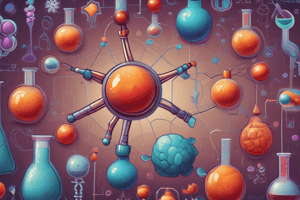Podcast
Questions and Answers
What is the composition of an atom?
What is the composition of an atom?
- Protons, isobars, and electrons
- Protons, neutrons, and electrons (correct)
- Protons and electrons
- Neutrons and electrons
Which subatomic particle is found in the nucleus of an atom and carries a positive charge?
Which subatomic particle is found in the nucleus of an atom and carries a positive charge?
- Neutrons
- Electrons
- Isotopes
- Protons (correct)
What defines an element in chemistry?
What defines an element in chemistry?
- Participating in ionic bonds
- Unique atomic number and composition (correct)
- Breakdown into simpler substances through chemical reactions
- Ability to form molecules
How are molecules formed?
How are molecules formed?
What type of bond involves the transfer of electrons between atoms?
What type of bond involves the transfer of electrons between atoms?
Which process involves the transformation of substances into different substances?
Which process involves the transformation of substances into different substances?
What must be the overall change in the number of atoms of each element in a balanced chemical equation?
What must be the overall change in the number of atoms of each element in a balanced chemical equation?
Which substances can accept or donate protons respectively?
Which substances can accept or donate protons respectively?
What is the purpose of the pH scale?
What is the purpose of the pH scale?
What does a pH value below 7 indicate about a solution?
What does a pH value below 7 indicate about a solution?
What practical application has resulted from understanding atomic structure?
What practical application has resulted from understanding atomic structure?
How do acids and bases react with each other to form products?
How do acids and bases react with each other to form products?
Study Notes
Exploring the Building Blocks of Chemistry
In the realm of science known as chemistry, we delve into the world of atoms, elements, molecules, and their interactions. Understanding these fundamental concepts is the foundation of our explorations into the chemical world, where matter and energy intertwine in a myriad of ways.
Atoms
Atoms are the smallest unit of an element that can exist independently. They are composed of protons, neutrons, and electrons. Protons are positively charged and are found in the nucleus, while neutrons are also found in the nucleus and are neutral. Electrons orbit around the nucleus in distinct energy levels, known as atomic orbitals.
Elements
Elements are substances that cannot be broken down into simpler substances through ordinary chemical reactions. Each element has its own unique atomic number, which is the number of protons in its atomic nucleus. Elements can exist in different forms called isotopes, which have the same atomic number but different numbers of neutrons.
Molecules
Molecules are formed when atoms bond together to form stable structures. In a covalent bond, atoms share electrons, while in an ionic bond, electrons are transferred between atoms, creating charged ions. Molecules can be classified as organic or inorganic depending on whether they contain carbon atoms or not.
Chemical Reactions
Chemical reactions are processes in which substances are transformed into different substances, forming products. Reactions can be balanced by writing the number of atoms of each element on either side of the chemical equation. The mole ratio of reactants to products is always equal, and the overall change in the number of atoms of each element must be zero.
Acids and Bases
Acids and bases are substances that can accept or donate protons, respectively. Acids have a tendency to lose hydrogen ions (protons) and gain electrons, while bases have a tendency to gain hydrogen ions (protons) and lose electrons. Acids and bases can react with each other to form water and a salt, resulting in a neutralization reaction.
The pH scale is used to measure the acidity or alkalinity of a solution, with values between 0 and 14. Solutions with a pH below 7 are considered acidic, while those with a pH above 7 are considered alkaline or basic. The pH scale is a logarithmic scale, meaning that a pH change of 1 corresponds to a tenfold change in hydrogen ion concentration.
Examples and Applications
The concepts of atoms, elements, molecules, chemical reactions, and acids and bases are not merely theoretical constructs; they have practical applications in our everyday lives.
- Atoms: Understanding atomic structure has led to the development of nuclear power, which generates electricity through controlled nuclear reactions.
- Elements: The periodic table of elements has aided chemists in discovering new elements and understanding their properties.
- Molecules: Understanding molecular structure has led to the development of drugs, plastics, and other materials.
- Chemical Reactions: Understanding chemical reactions has led to the development of processes to convert raw materials into useful products, such as the Haber-Bosch process for producing ammonia.
- Acids and Bases: Understanding acids and bases has led to the development of cleaning agents, food preservation techniques, and the regulation of environmental pH levels.
Chemistry is a fascinating field that continues to uncover new insights and applications. By understanding the building blocks and processes of chemistry, we can appreciate the world around us in a new light and work towards a better future through scientific advancements.
Studying That Suits You
Use AI to generate personalized quizzes and flashcards to suit your learning preferences.
Description
Delve into the world of atoms, elements, molecules, chemical reactions, and acids and bases to understand the fundamental building blocks of chemistry. Explore how these concepts shape the chemical world and have practical applications in various fields.




